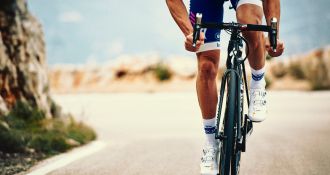

It's that time of year when we all want to spend longer and longer out on our bikes as the weather keeps improving and daylight is in greater supply. More hours in the saddle means more demand on the body and a greater consumption of energy. So not only are we able to eat more (whoopee!) but we need to be mindful of what we put into our bodies as fuel. When targeting greater distance or duration, whether alone or during an event, the timing of our energy consumption is hugely important.
Breakfast of Champions
What you choose to eat for breakfast depends on a lot of things. If you're hoping to lose weight as well as fuel your ride, then you'll want to cut carbohydrates out of your breakfast, perhaps going for a three-egg omelette and half avocado. However, if you're wanting to provide your body with plenty of fuel in order to maximise your potential on the ride, then a slow-rise carbohydrate supply like porridge will do the job. The next thing to consider is when you should eat your breakfast. Ideally, you want to be eating no less than 90 minutes before you start riding to give the food a chance to digest.
Hydration
It is easy to neglect your liquid intake on long rides in favour of solid foods, but to avoid cramping - and as a secondary means of topping up your energy reserves - hydration is vital. A naturally-flavoured energy drink with electrolytes is lighter on the stomach than gels and easier to consume than food, so for those high intensity efforts, a product like the Torq Energy Drink will serve you well. It is a carbohydrate powder designed to maintain hydration and replace electrolytes lost through perspiration. The best thing though, like all Torq products, the drink actually manages to taste like the flavour advertised on the packaging. Take a gulp every ten or fifteen minutes, or as and when you need it, to get the full benefit.
Solid Ride Fuel
Many cyclists would far prefer to eat solid foods than gels on long rides, and although they may be bulkier in your back pocket, they will provide a better source of fuel with greater longevity than a liquid alternative. Homemade flapjacks or rice cakes can liven up your fuelling significantly, but if you don't have the time or the inclination, most sports nutrition brands make great energy bars to satisfy your solid food craving. Science in Sport make some of the tastiest fruit bars available, a high carbohydrate snack sourced from oats, rice, corn and real fruit, with no added sugar, providing a consistent energy release and a good source of soluble fibre.
Gels
On long rides, it is not a good idea to rely solely on energy gels, as their energy supply is usually short-lived and the sugar content means that you will very quickly find yourself craving more - or worse, having a sugar crash.
However, as a fast and convenient energy boost, there are few better means of taking on fuel than in a gel. The sticky, syrupy, sachets contain masses of carbohydrates, electrolytes and often a great deal of caffeine to give you that mental and physical boost. Gels are best left to the tail end of a ride or before key Strava segments, when fast-acting fuel is required.
At the Café
A long ride is never complete without a good café stop, but what should you take on while there? Well, it depends a lot on how far through your ride you are. If the café comes at the very end, then eat to start your recovery without going overboard. If, however, you still have a couple of hours programmed into your route, then you're going to want to keep away from heavy carbohydrates like bread. By all means eat a slice of cake or flapjack, something high in sugar, to top up your energy, but you're going to want to stay away from stodgy foods that will fill your legs with lead. Cap off with an espresso ten minutes before you leave, and you'll be ready to enjoy the rest of your ride.